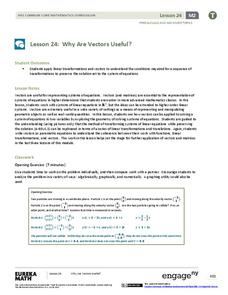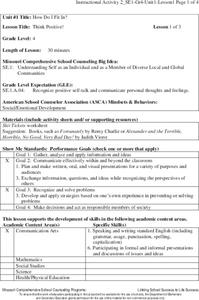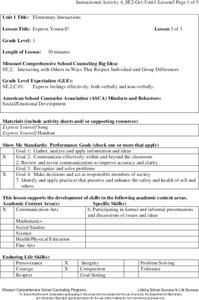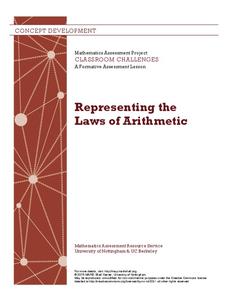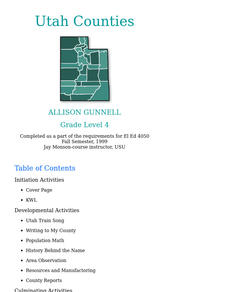Concord Consortium
The Line and the Ellipse
What do a line and an ellipse have in common? Maybe zero, one, or two points! Learners consider the equation of an ellipse and a line to determine if their graphs have any shared points. They then write a system of equations, including...
Missouri Department of Elementary
Friendship Line Dancing
Develop social awareness with a lesson that challenges scholars to properly communicate with their peers. Standing in two lines, participants practice introducing themselves, asking how their partner is feeling, asks if they want to...
Cornell University
Spectral Analysis with DVDs and CDs
Build a spectrometer to analyze properties of light. Scholars examine the spectrum from CDs and DVDs from two different light sources. Using the spectrum, they work to identify different elements.
Mathed Up!
Ordering Numbers
Young mathematicians order numbers from least to greatest. Number types include whole numbers, decimals, and negative numbers.
Mathed Up!
Angles
What does a geometric farmer drive? A protractor, of course! A set of assessment worksheets prompts learners to use a protractor as they measure angles, name angles, and identify lines. Use the video as a way to...
EngageNY
Why Are Vectors Useful? 2
Investigate the application of vector transformations applied to linear systems. Individuals use vectors to transform a linear system translating the solution to the origin. They apply their understanding of vectors, matrices,...
Curated OER
7 Habits of Highly Effective Teens
How many good habits does it take to be a successful adolescent? According to The 7 Habits of Highly Effective Teens by Sean Covey, just seven! Using the worksheets, learners answer personal growth questions and develop strategies...
Missouri Department of Elementary
Think Positive!
Following an attention-grabbing read-aloud, scholars brainstorm ways they can change negative thoughts into positive thoughts. Small groups plan and perform a skit that showcases one of the new ideas to uplift one's feelings....
Missouri Department of Elementary
I’m Thumbody!
Positive and negative thinking is the focus of a lesson that boost self-awareness. Beginning with a whole-class discussion, scholars brainstorm what positive thinking looks and sounds like then compares and contrast the two types of...
Missouri Department of Elementary
Are You Balanced?
Balance scales create a strong visual of how an individual prioritizes one's self alongside their commitments to the community, school, and home. Scholars complete a graphic organizer then discuss their findings with their peers. A...
Missouri Department of Elementary
What Does Respect Look Like at Home?
Individuals consider why is it important to respect family members as they complete a self-respect survey to assess their respectful behaviors at home. They then choose three items from the survey and write about how they plan to improve...
Missouri Department of Elementary
Express Yourself!
Encourage scholars to express themselves with help from an engaging song. Sung to the tune of "London Bridge is Falling Down," participants sing phrases that offer tips for dealing with emotions—sad, happy, worried, proud, mad, and...
Missouri Department of Elementary
Communicating with I-Messages (1/2)
Scholars watch two puppet dialogues illustrating negative and positive communication between friends. Then, they discuss how the puppets' communication skills influenced the outcome of each interaction.
Missouri Department of Elementary
Opportunity Knocks, But It Costs, Too!
Sixth graders practice six steps to effective problem solving. Working with the school counselor, class members are presented with a scenario that requires them to make a decision. Individuals then write a reflection in which they...
Dawgeared.com
Book Review
Reflect on your reading with a book review form. After finishing a novel or short story, kids choose the correct genre and discuss their favorite part. They also decide which part they would change, and whether or not they would...
Hello-Hello
Portuguese – Learn Portuguese
Marcos and Paulo have just met Ana. Watch as they use Portuguese to introduce themselves and get to know each other. Language learners then complete a series of activities designed to help them master each brief conversation.
Mathematics Assessment Project
Representing the Laws of Arithmetic
Sixth graders connect numerical expressions to geometric area. They first complete an assessment task requiring them to identify area models for numerical expressions. Learners then participate in an activity to match area models to...
Biology Corner
Technology and Inventions Project
Technology—what exactly is it? Find out with a project designed to inspire the inner inventor in us all. The activity begins with a captivating podcast and a search of multiple websites that display different inventions and technology,...
Curated OER
Utah Counties
Learners write a business letter in correct format and obtain information about the county they are studying and use that information in their county report.
Curated OER
Ways Twitter Makes You a Better Writer
Practice being concise. Exercise your vocabulary. Improve your editing skills. The contention in this instructional activity is that by imposing a 140 character limit, the Twitter format actually helps improve writing skills. And of...
Curated OER
Module 7--Socializing
In this socializing worksheet, students write a response to seven statements that people might say, think of a creative way to reply to seven sentences and write a sentence for one social custom from eight various countries.
Curated OER
Summarizing Key Information
Imagine the surprise when small groups present their Evidence Charts to the class and discover that each group has studied a different version of the Cinderella story. Irish, Ojibwa, Egyptian, Chinese, Korean, Persian, Mexican, and...
Curated OER
Seasons: Writing Complete Sentences
In this sentence worksheet, students look at one picture for each season, then write a complete sentence for each picture. Lines are provided for sentences.
Curated OER
Picture Writing
Fourth graders create symbols. In this visual arts instructional activity, 4th graders study cave drawings, Native American pictographs, and Aboriginal Drawings prior to creating their own communication without using words.





